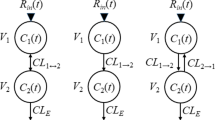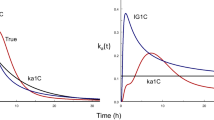Abstract
The linear trapezoidal rule method is commonly used for the estimation of the area under the plasma level-time curve. Error analyses are performed when the method is used in first-order absorption and first-order elimination kinetics in the one-compartment system. It is found that significant underestimations and overestimations in area during the absorption phase and postabsorption phase, respectively, can occur when the method is improperly used. During the exponential postabsorption phase the relative error is only a function of the ratio (n)of the time interval over the half-life of the two plasma data points in the interval. The error from the linear trapezoidal rule method at n=0.5 is about 1%. The error increases to 15.5% and 57.1 % when nis increased to 2 and 4, respectively. It is recommended that for most absorption studies the linear trapezoidal method be used for prepeak and plateau plasma data and the logarithmic trapezoidal method for postpeak plasma data.
Similar content being viewed by others
References
S. A. Kaplan. Biopharmaceutics in the pre-formulation stages of drug development. In J. Swarbrick (ed.),Current Concepts in the Pharmaceutical Sciences: Dosage Form Design and Bioavailability, Lea and Febiger, Philadelphia, 1973, Chap. 1.
M. Gibaldi and D. Perrier.Pharmacokinetics, Dekker, 1975, pp. 67, 132, and 293.
D.S. Riggs.The Mathematical Approach to Physiological Problems, Williams and Wilkins, Baltimore, 1967.
W. L. Chiou, M. A. F. Gadalla, and G. W. Peng. Method for the rapid estimation of the total body drug clearance and adjustment of dosage regimens in patients during a constant-rate intravenous infusion.J. Pharmacokin. Biopharm. 6:135–152 (1978).
K. C. Yeh and K. C. Kwan. A comparison of numerical integrating logarithms by trapezoidal, Lagrange, and spline approximation.J. Pharmacokin. Biopharm. 6:79–98 (1978).
P. G. Welling, L. L. Lyons, W. A. Craig, and G. A. Trochta. Influence of diet and fluid on bioavailability of theophylline.Clin. Pharmacol. Ther. 17:475–480 (1975).
P. G. Welling, P. A. Koch, C. C. Lau, and W. A. Craig. Bioavailability of tetracycline and doscycline in fasted and nonfasted subjects.Antimicrob. Agents Chemother. 11:462–469 (1977).
S. A. Kaplan, R. E. Weinfeld, C. W. Abruzzo, and M. Lewis. Pharmacokinetic profile of sulfisoxazole following intravenous, intramuscular, and oral administration to man.J. Pharm. Sci. 61:773–778 (1972).
C. T. Ueda and B. S. Dzindzio. Quinidine kinetics in congestive heart failure.Clin. Pharmacol. Ther. 23:158–164 (1978).
K. C. Kwan and A. E. Till. Novel method for bioavailability assessment.J. Pharm. Sci. 62:1494–1497 (1973).
A. E. Till, L. Z. Benet, and K. C. Kwan. An integrated approach to the pharmacokinetic analysis of drug absorption.J. Pharmacokin. Biopharm. 2:525–544 (1974).
Author information
Authors and Affiliations
Rights and permissions
About this article
Cite this article
Chiou, W.L. Critical evaluation of the potential error in pharmacokinetic studies of using the linear trapezoidal rule method for the calculation of the area under the plasma level-time curve. Journal of Pharmacokinetics and Biopharmaceutics 6, 539–546 (1978). https://doi.org/10.1007/BF01062108
Received:
Revised:
Published:
Issue Date:
DOI: https://doi.org/10.1007/BF01062108




